McDonald's Case Study: Capacity Management and Operational Performance
VerifiedAdded on 2022/12/28
|10
|2750
|32
AI Summary
This case study assesses the capacity management and operational performance of McDonald's, including approaches used to reconcile capacity and demand, implementation of the four Ds, and evaluation of performance objectives.
Contribute Materials
Your contribution can guide someone’s learning journey. Share your
documents today.

McDonald's Case Study
Assessment
1
Assessment
1
Secure Best Marks with AI Grader
Need help grading? Try our AI Grader for instant feedback on your assignments.

Contents
Introduction......................................................................................................................................3
Section B..........................................................................................................................................3
Approaches used by McDonald's to reconcile capacity and demand under capacity
management.................................................................................................................................3
Analysis of implementation of the four Ds by the McDonald's restaurant..................................5
Evaluation of five performance objectives for the operation in McDonald's..............................6
Calculate average number of customers arriving........................................................................8
Conclusion.......................................................................................................................................9
References......................................................................................................................................10
2
Introduction......................................................................................................................................3
Section B..........................................................................................................................................3
Approaches used by McDonald's to reconcile capacity and demand under capacity
management.................................................................................................................................3
Analysis of implementation of the four Ds by the McDonald's restaurant..................................5
Evaluation of five performance objectives for the operation in McDonald's..............................6
Calculate average number of customers arriving........................................................................8
Conclusion.......................................................................................................................................9
References......................................................................................................................................10
2
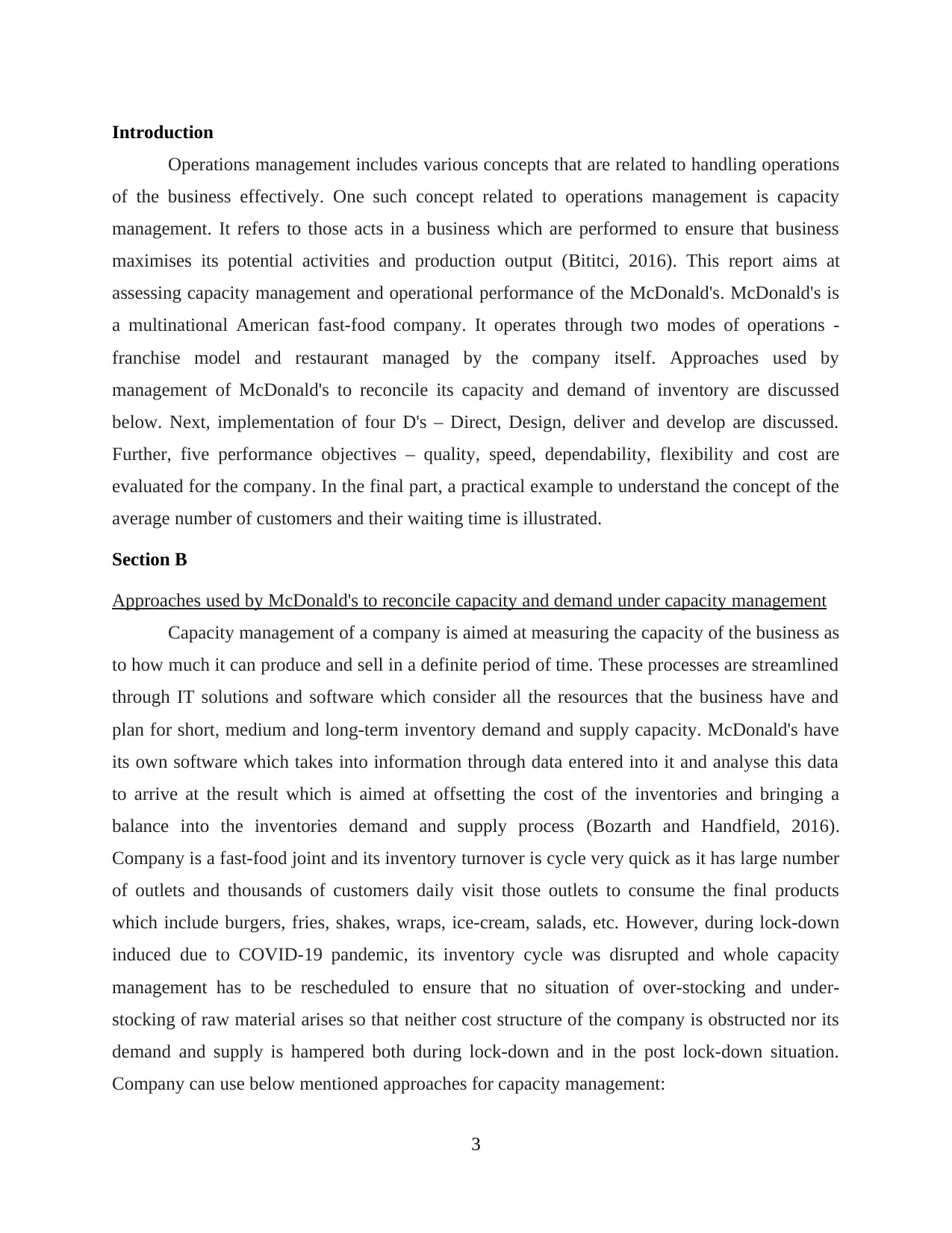
Introduction
Operations management includes various concepts that are related to handling operations
of the business effectively. One such concept related to operations management is capacity
management. It refers to those acts in a business which are performed to ensure that business
maximises its potential activities and production output (Bititci, 2016). This report aims at
assessing capacity management and operational performance of the McDonald's. McDonald's is
a multinational American fast-food company. It operates through two modes of operations -
franchise model and restaurant managed by the company itself. Approaches used by
management of McDonald's to reconcile its capacity and demand of inventory are discussed
below. Next, implementation of four D's – Direct, Design, deliver and develop are discussed.
Further, five performance objectives – quality, speed, dependability, flexibility and cost are
evaluated for the company. In the final part, a practical example to understand the concept of the
average number of customers and their waiting time is illustrated.
Section B
Approaches used by McDonald's to reconcile capacity and demand under capacity management
Capacity management of a company is aimed at measuring the capacity of the business as
to how much it can produce and sell in a definite period of time. These processes are streamlined
through IT solutions and software which consider all the resources that the business have and
plan for short, medium and long-term inventory demand and supply capacity. McDonald's have
its own software which takes into information through data entered into it and analyse this data
to arrive at the result which is aimed at offsetting the cost of the inventories and bringing a
balance into the inventories demand and supply process (Bozarth and Handfield, 2016).
Company is a fast-food joint and its inventory turnover is cycle very quick as it has large number
of outlets and thousands of customers daily visit those outlets to consume the final products
which include burgers, fries, shakes, wraps, ice-cream, salads, etc. However, during lock-down
induced due to COVID-19 pandemic, its inventory cycle was disrupted and whole capacity
management has to be rescheduled to ensure that no situation of over-stocking and under-
stocking of raw material arises so that neither cost structure of the company is obstructed nor its
demand and supply is hampered both during lock-down and in the post lock-down situation.
Company can use below mentioned approaches for capacity management:
3
Operations management includes various concepts that are related to handling operations
of the business effectively. One such concept related to operations management is capacity
management. It refers to those acts in a business which are performed to ensure that business
maximises its potential activities and production output (Bititci, 2016). This report aims at
assessing capacity management and operational performance of the McDonald's. McDonald's is
a multinational American fast-food company. It operates through two modes of operations -
franchise model and restaurant managed by the company itself. Approaches used by
management of McDonald's to reconcile its capacity and demand of inventory are discussed
below. Next, implementation of four D's – Direct, Design, deliver and develop are discussed.
Further, five performance objectives – quality, speed, dependability, flexibility and cost are
evaluated for the company. In the final part, a practical example to understand the concept of the
average number of customers and their waiting time is illustrated.
Section B
Approaches used by McDonald's to reconcile capacity and demand under capacity management
Capacity management of a company is aimed at measuring the capacity of the business as
to how much it can produce and sell in a definite period of time. These processes are streamlined
through IT solutions and software which consider all the resources that the business have and
plan for short, medium and long-term inventory demand and supply capacity. McDonald's have
its own software which takes into information through data entered into it and analyse this data
to arrive at the result which is aimed at offsetting the cost of the inventories and bringing a
balance into the inventories demand and supply process (Bozarth and Handfield, 2016).
Company is a fast-food joint and its inventory turnover is cycle very quick as it has large number
of outlets and thousands of customers daily visit those outlets to consume the final products
which include burgers, fries, shakes, wraps, ice-cream, salads, etc. However, during lock-down
induced due to COVID-19 pandemic, its inventory cycle was disrupted and whole capacity
management has to be rescheduled to ensure that no situation of over-stocking and under-
stocking of raw material arises so that neither cost structure of the company is obstructed nor its
demand and supply is hampered both during lock-down and in the post lock-down situation.
Company can use below mentioned approaches for capacity management:
3

Figure 1 Capacity planning and control
Demand management – It is a planning methodology that aims at forecasting the
demand of the products and services. Based on the demand forecasted, a plan has to be
drawn up to manage the demand portfolio. McDonald's has a defined demand
management process under its capacity management process solution which needed to be
modified to suit the changes in both demand and supply during lock-down and post lock-
down recovery phase. Data analysis will be rescheduled with the aim of analysing
demand level of raw materials in accordance with the demand of finished products. This
strategy would enable higher profits by helping maintenance of supply chain processes in
just-in-time method (Lun and et.al., 2016).
Level Capacity strategy – This is a demand management strategy which involves
workforce planning as well. It aims to stabilises workforce level and output rates over
planning horizon. Adopting this strategy would enable McDonald's to maintain inventory
levels of finished products in its outlets higher than what is expected in situations of low
demand variability. IT solutions of McDonald's capacity management has data required
for its operations in normal days. This demand was however dropped in lock-down as
4
Demand management – It is a planning methodology that aims at forecasting the
demand of the products and services. Based on the demand forecasted, a plan has to be
drawn up to manage the demand portfolio. McDonald's has a defined demand
management process under its capacity management process solution which needed to be
modified to suit the changes in both demand and supply during lock-down and post lock-
down recovery phase. Data analysis will be rescheduled with the aim of analysing
demand level of raw materials in accordance with the demand of finished products. This
strategy would enable higher profits by helping maintenance of supply chain processes in
just-in-time method (Lun and et.al., 2016).
Level Capacity strategy – This is a demand management strategy which involves
workforce planning as well. It aims to stabilises workforce level and output rates over
planning horizon. Adopting this strategy would enable McDonald's to maintain inventory
levels of finished products in its outlets higher than what is expected in situations of low
demand variability. IT solutions of McDonald's capacity management has data required
for its operations in normal days. This demand was however dropped in lock-down as
4
Secure Best Marks with AI Grader
Need help grading? Try our AI Grader for instant feedback on your assignments.
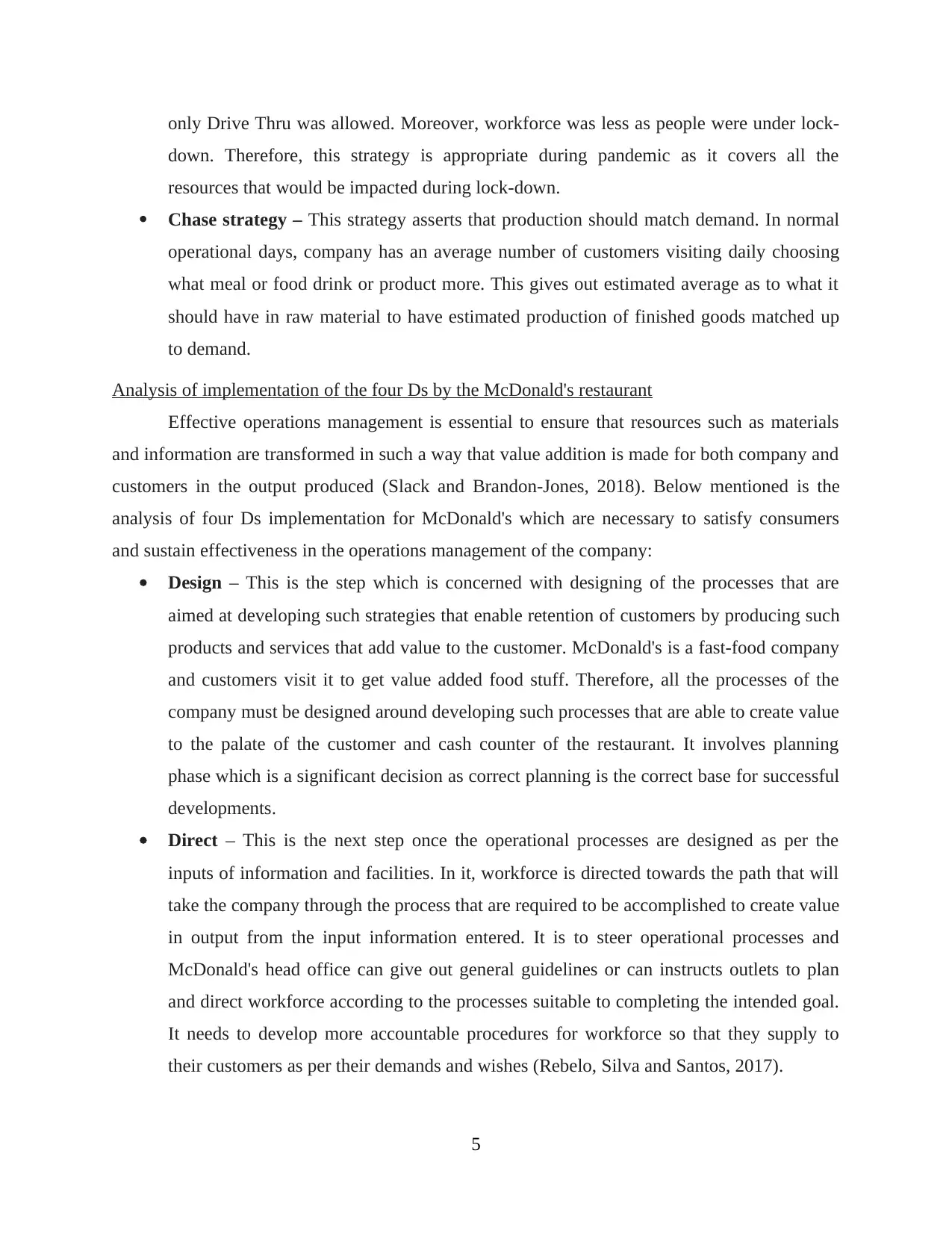
only Drive Thru was allowed. Moreover, workforce was less as people were under lock-
down. Therefore, this strategy is appropriate during pandemic as it covers all the
resources that would be impacted during lock-down.
Chase strategy – This strategy asserts that production should match demand. In normal
operational days, company has an average number of customers visiting daily choosing
what meal or food drink or product more. This gives out estimated average as to what it
should have in raw material to have estimated production of finished goods matched up
to demand.
Analysis of implementation of the four Ds by the McDonald's restaurant
Effective operations management is essential to ensure that resources such as materials
and information are transformed in such a way that value addition is made for both company and
customers in the output produced (Slack and Brandon-Jones, 2018). Below mentioned is the
analysis of four Ds implementation for McDonald's which are necessary to satisfy consumers
and sustain effectiveness in the operations management of the company:
Design – This is the step which is concerned with designing of the processes that are
aimed at developing such strategies that enable retention of customers by producing such
products and services that add value to the customer. McDonald's is a fast-food company
and customers visit it to get value added food stuff. Therefore, all the processes of the
company must be designed around developing such processes that are able to create value
to the palate of the customer and cash counter of the restaurant. It involves planning
phase which is a significant decision as correct planning is the correct base for successful
developments.
Direct – This is the next step once the operational processes are designed as per the
inputs of information and facilities. In it, workforce is directed towards the path that will
take the company through the process that are required to be accomplished to create value
in output from the input information entered. It is to steer operational processes and
McDonald's head office can give out general guidelines or can instructs outlets to plan
and direct workforce according to the processes suitable to completing the intended goal.
It needs to develop more accountable procedures for workforce so that they supply to
their customers as per their demands and wishes (Rebelo, Silva and Santos, 2017).
5
down. Therefore, this strategy is appropriate during pandemic as it covers all the
resources that would be impacted during lock-down.
Chase strategy – This strategy asserts that production should match demand. In normal
operational days, company has an average number of customers visiting daily choosing
what meal or food drink or product more. This gives out estimated average as to what it
should have in raw material to have estimated production of finished goods matched up
to demand.
Analysis of implementation of the four Ds by the McDonald's restaurant
Effective operations management is essential to ensure that resources such as materials
and information are transformed in such a way that value addition is made for both company and
customers in the output produced (Slack and Brandon-Jones, 2018). Below mentioned is the
analysis of four Ds implementation for McDonald's which are necessary to satisfy consumers
and sustain effectiveness in the operations management of the company:
Design – This is the step which is concerned with designing of the processes that are
aimed at developing such strategies that enable retention of customers by producing such
products and services that add value to the customer. McDonald's is a fast-food company
and customers visit it to get value added food stuff. Therefore, all the processes of the
company must be designed around developing such processes that are able to create value
to the palate of the customer and cash counter of the restaurant. It involves planning
phase which is a significant decision as correct planning is the correct base for successful
developments.
Direct – This is the next step once the operational processes are designed as per the
inputs of information and facilities. In it, workforce is directed towards the path that will
take the company through the process that are required to be accomplished to create value
in output from the input information entered. It is to steer operational processes and
McDonald's head office can give out general guidelines or can instructs outlets to plan
and direct workforce according to the processes suitable to completing the intended goal.
It needs to develop more accountable procedures for workforce so that they supply to
their customers as per their demands and wishes (Rebelo, Silva and Santos, 2017).
5

Develop – It aims to improve capabilities of operations so that value is added for
customers in output products and services. It includes development of renewed
production technologies that will help the company serve their customers better.
McDonald's always strives to deliver better facilities and services to the customers. They
regularly engage in gauging customer expectations so that they can develop improvement
in their customer processes and their work forces can be trained accordingly. McDonald's
takes into factor market analysis and demand management of customers so that they can
develop new products, new offers, new variants in meals so that they can attract more and
more customers.
Deliver – This step is about planning and controlling on-going operations related to
facilities and workforce management. Distribution mechanism of the company is
assessed in this step as its effectiveness ensures that customer feedback is positive
(Stubbs, 2019). For example, customers in McDonald's order their demanded product and
they are delivered the product. It could be outlet delivery, home delivery or Drive Thru.
All the processes that are included in the delivery processes can be counted in this step.
This is a crucial step as it is the final step where an order is completed and smooth and
quick delivery leaves a lasting impact on the customer.
Evaluation of five performance objectives for the operation in McDonald's
Performance objectives refers to those targets that are set to evaluate the level of
effectiveness of the operations of the business. Below mentioned is the performance evaluation
of McDonald’s on five mentioned performance objectives:
6
customers in output products and services. It includes development of renewed
production technologies that will help the company serve their customers better.
McDonald's always strives to deliver better facilities and services to the customers. They
regularly engage in gauging customer expectations so that they can develop improvement
in their customer processes and their work forces can be trained accordingly. McDonald's
takes into factor market analysis and demand management of customers so that they can
develop new products, new offers, new variants in meals so that they can attract more and
more customers.
Deliver – This step is about planning and controlling on-going operations related to
facilities and workforce management. Distribution mechanism of the company is
assessed in this step as its effectiveness ensures that customer feedback is positive
(Stubbs, 2019). For example, customers in McDonald's order their demanded product and
they are delivered the product. It could be outlet delivery, home delivery or Drive Thru.
All the processes that are included in the delivery processes can be counted in this step.
This is a crucial step as it is the final step where an order is completed and smooth and
quick delivery leaves a lasting impact on the customer.
Evaluation of five performance objectives for the operation in McDonald's
Performance objectives refers to those targets that are set to evaluate the level of
effectiveness of the operations of the business. Below mentioned is the performance evaluation
of McDonald’s on five mentioned performance objectives:
6
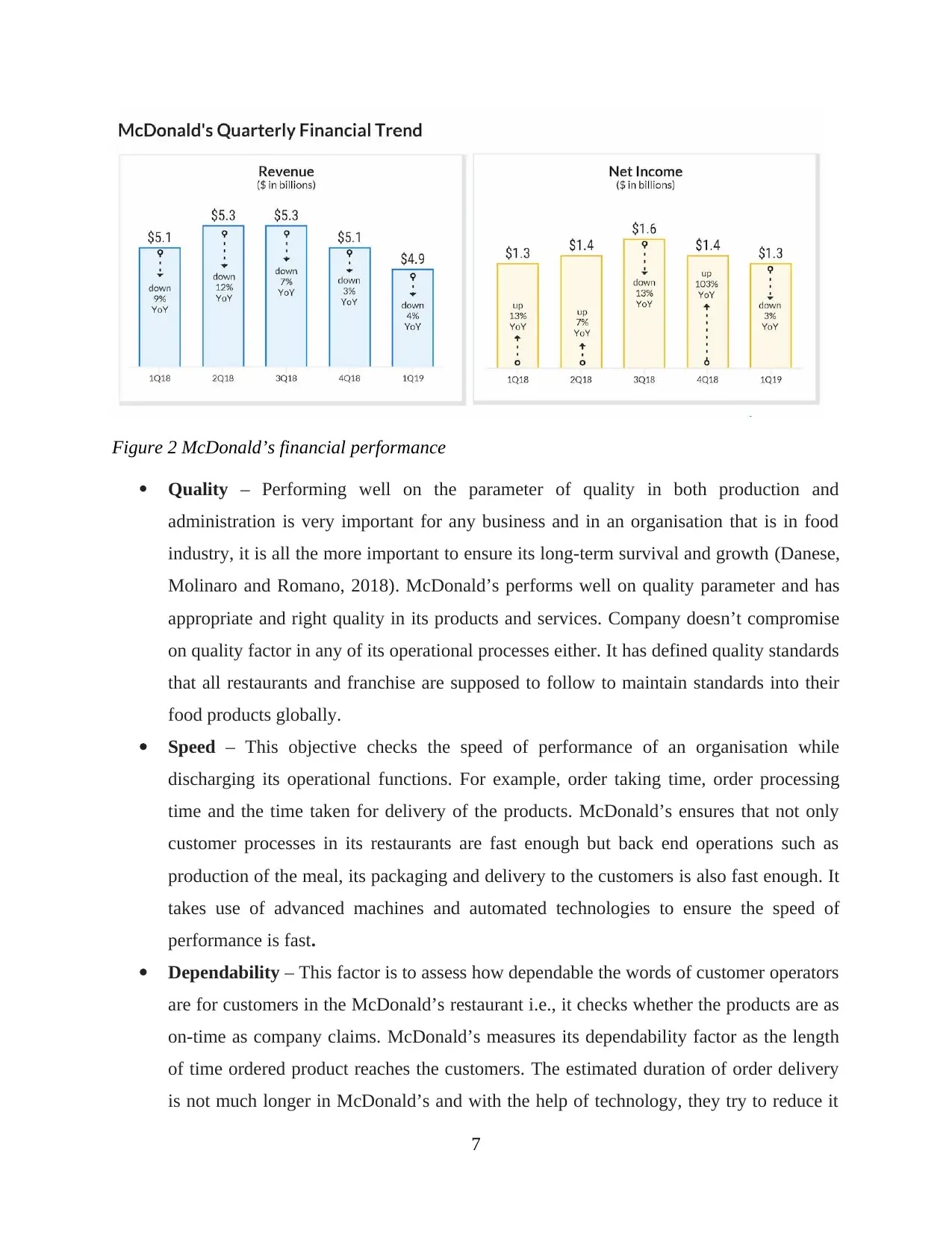
Figure 2 McDonald’s financial performance
Quality – Performing well on the parameter of quality in both production and
administration is very important for any business and in an organisation that is in food
industry, it is all the more important to ensure its long-term survival and growth (Danese,
Molinaro and Romano, 2018). McDonald’s performs well on quality parameter and has
appropriate and right quality in its products and services. Company doesn’t compromise
on quality factor in any of its operational processes either. It has defined quality standards
that all restaurants and franchise are supposed to follow to maintain standards into their
food products globally.
Speed – This objective checks the speed of performance of an organisation while
discharging its operational functions. For example, order taking time, order processing
time and the time taken for delivery of the products. McDonald’s ensures that not only
customer processes in its restaurants are fast enough but back end operations such as
production of the meal, its packaging and delivery to the customers is also fast enough. It
takes use of advanced machines and automated technologies to ensure the speed of
performance is fast.
Dependability – This factor is to assess how dependable the words of customer operators
are for customers in the McDonald’s restaurant i.e., it checks whether the products are as
on-time as company claims. McDonald’s measures its dependability factor as the length
of time ordered product reaches the customers. The estimated duration of order delivery
is not much longer in McDonald’s and with the help of technology, they try to reduce it
7
Quality – Performing well on the parameter of quality in both production and
administration is very important for any business and in an organisation that is in food
industry, it is all the more important to ensure its long-term survival and growth (Danese,
Molinaro and Romano, 2018). McDonald’s performs well on quality parameter and has
appropriate and right quality in its products and services. Company doesn’t compromise
on quality factor in any of its operational processes either. It has defined quality standards
that all restaurants and franchise are supposed to follow to maintain standards into their
food products globally.
Speed – This objective checks the speed of performance of an organisation while
discharging its operational functions. For example, order taking time, order processing
time and the time taken for delivery of the products. McDonald’s ensures that not only
customer processes in its restaurants are fast enough but back end operations such as
production of the meal, its packaging and delivery to the customers is also fast enough. It
takes use of advanced machines and automated technologies to ensure the speed of
performance is fast.
Dependability – This factor is to assess how dependable the words of customer operators
are for customers in the McDonald’s restaurant i.e., it checks whether the products are as
on-time as company claims. McDonald’s measures its dependability factor as the length
of time ordered product reaches the customers. The estimated duration of order delivery
is not much longer in McDonald’s and with the help of technology, they try to reduce it
7
Paraphrase This Document
Need a fresh take? Get an instant paraphrase of this document with our AI Paraphraser
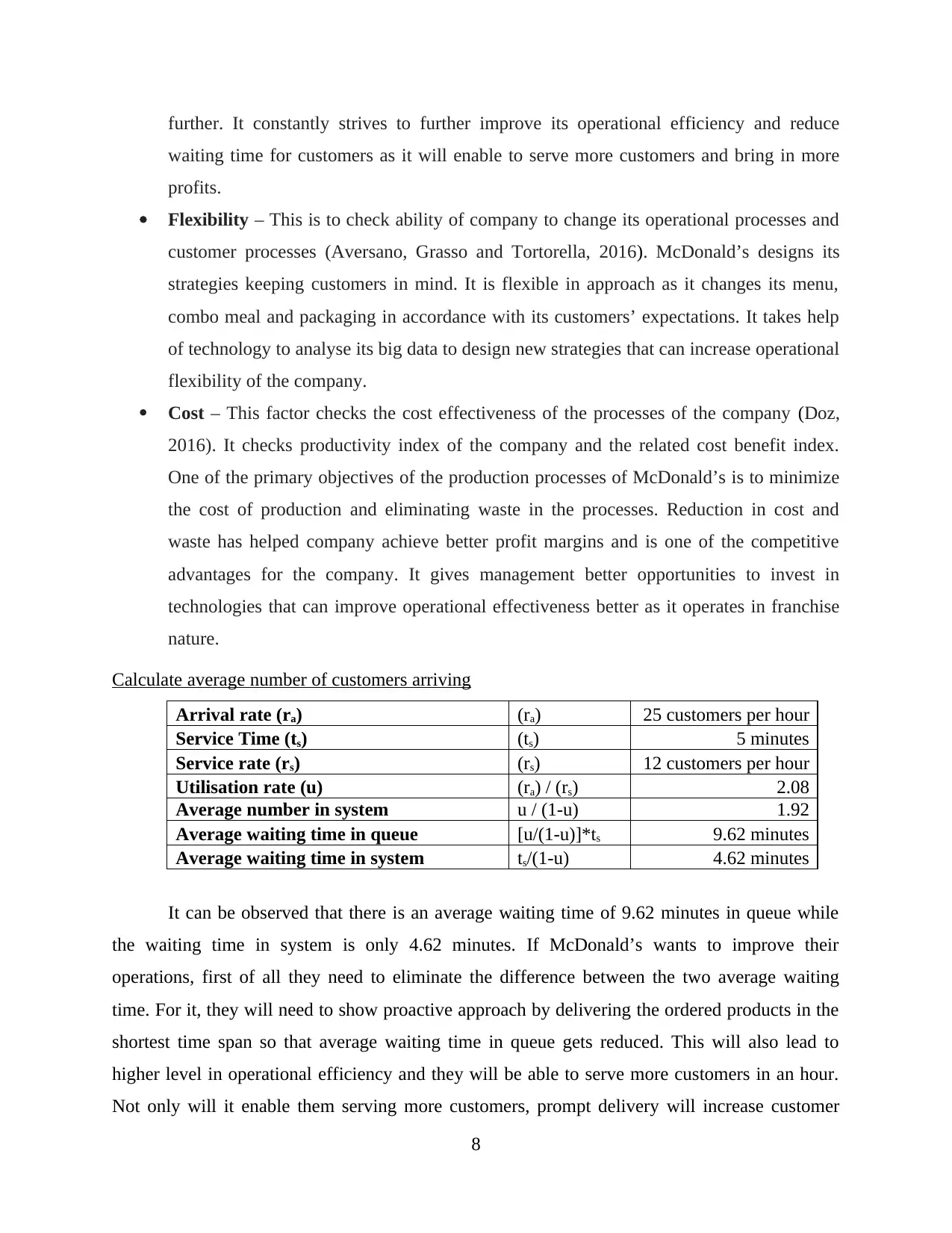
further. It constantly strives to further improve its operational efficiency and reduce
waiting time for customers as it will enable to serve more customers and bring in more
profits.
Flexibility – This is to check ability of company to change its operational processes and
customer processes (Aversano, Grasso and Tortorella, 2016). McDonald’s designs its
strategies keeping customers in mind. It is flexible in approach as it changes its menu,
combo meal and packaging in accordance with its customers’ expectations. It takes help
of technology to analyse its big data to design new strategies that can increase operational
flexibility of the company.
Cost – This factor checks the cost effectiveness of the processes of the company (Doz,
2016). It checks productivity index of the company and the related cost benefit index.
One of the primary objectives of the production processes of McDonald’s is to minimize
the cost of production and eliminating waste in the processes. Reduction in cost and
waste has helped company achieve better profit margins and is one of the competitive
advantages for the company. It gives management better opportunities to invest in
technologies that can improve operational effectiveness better as it operates in franchise
nature.
Calculate average number of customers arriving
Arrival rate (ra) (ra) 25 customers per hour
Service Time (ts) (ts) 5 minutes
Service rate (rs) (rs) 12 customers per hour
Utilisation rate (u) (ra) / (rs) 2.08
Average number in system u / (1-u) 1.92
Average waiting time in queue [u/(1-u)]*ts 9.62 minutes
Average waiting time in system ts/(1-u) 4.62 minutes
It can be observed that there is an average waiting time of 9.62 minutes in queue while
the waiting time in system is only 4.62 minutes. If McDonald’s wants to improve their
operations, first of all they need to eliminate the difference between the two average waiting
time. For it, they will need to show proactive approach by delivering the ordered products in the
shortest time span so that average waiting time in queue gets reduced. This will also lead to
higher level in operational efficiency and they will be able to serve more customers in an hour.
Not only will it enable them serving more customers, prompt delivery will increase customer
8
waiting time for customers as it will enable to serve more customers and bring in more
profits.
Flexibility – This is to check ability of company to change its operational processes and
customer processes (Aversano, Grasso and Tortorella, 2016). McDonald’s designs its
strategies keeping customers in mind. It is flexible in approach as it changes its menu,
combo meal and packaging in accordance with its customers’ expectations. It takes help
of technology to analyse its big data to design new strategies that can increase operational
flexibility of the company.
Cost – This factor checks the cost effectiveness of the processes of the company (Doz,
2016). It checks productivity index of the company and the related cost benefit index.
One of the primary objectives of the production processes of McDonald’s is to minimize
the cost of production and eliminating waste in the processes. Reduction in cost and
waste has helped company achieve better profit margins and is one of the competitive
advantages for the company. It gives management better opportunities to invest in
technologies that can improve operational effectiveness better as it operates in franchise
nature.
Calculate average number of customers arriving
Arrival rate (ra) (ra) 25 customers per hour
Service Time (ts) (ts) 5 minutes
Service rate (rs) (rs) 12 customers per hour
Utilisation rate (u) (ra) / (rs) 2.08
Average number in system u / (1-u) 1.92
Average waiting time in queue [u/(1-u)]*ts 9.62 minutes
Average waiting time in system ts/(1-u) 4.62 minutes
It can be observed that there is an average waiting time of 9.62 minutes in queue while
the waiting time in system is only 4.62 minutes. If McDonald’s wants to improve their
operations, first of all they need to eliminate the difference between the two average waiting
time. For it, they will need to show proactive approach by delivering the ordered products in the
shortest time span so that average waiting time in queue gets reduced. This will also lead to
higher level in operational efficiency and they will be able to serve more customers in an hour.
Not only will it enable them serving more customers, prompt delivery will increase customer
8
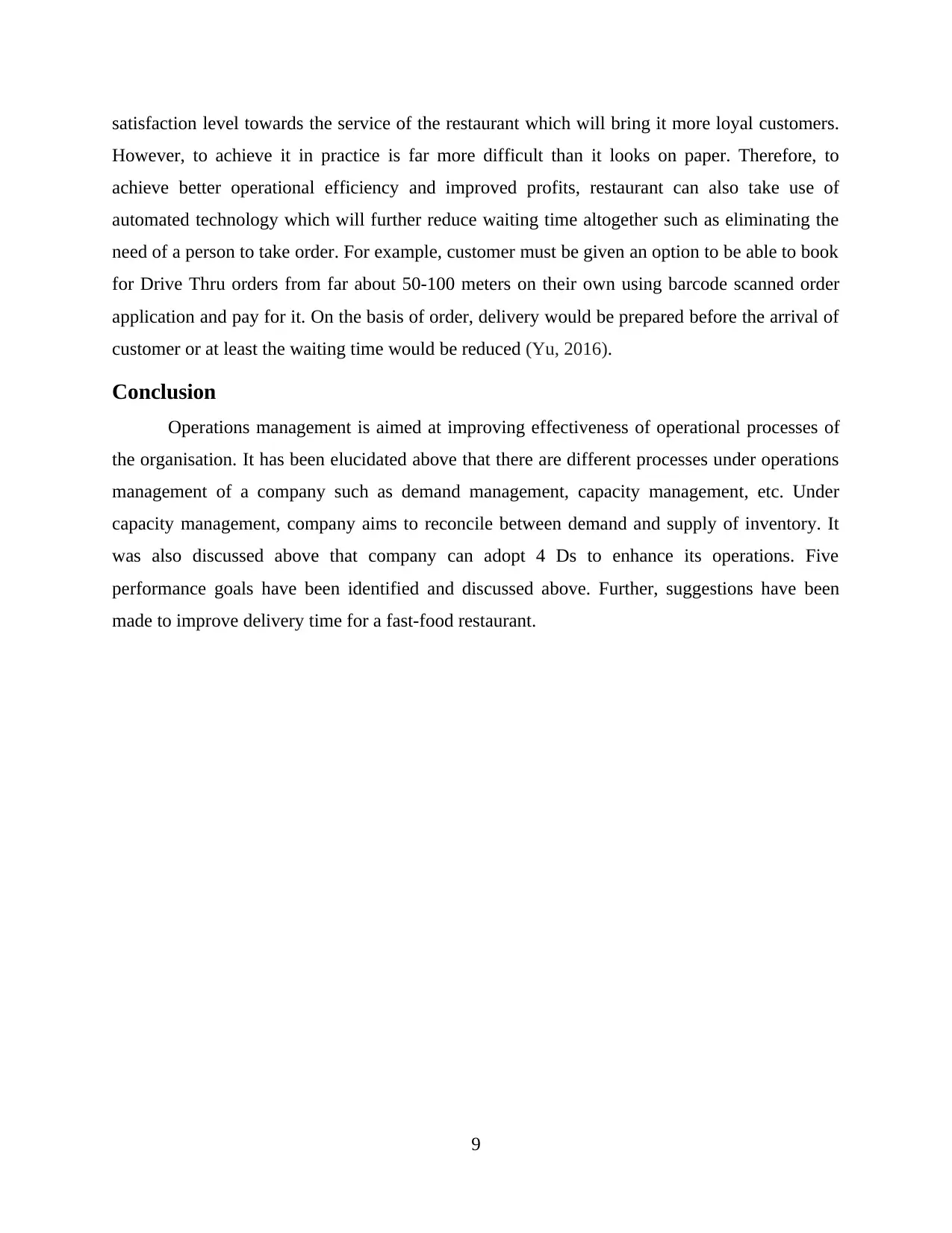
satisfaction level towards the service of the restaurant which will bring it more loyal customers.
However, to achieve it in practice is far more difficult than it looks on paper. Therefore, to
achieve better operational efficiency and improved profits, restaurant can also take use of
automated technology which will further reduce waiting time altogether such as eliminating the
need of a person to take order. For example, customer must be given an option to be able to book
for Drive Thru orders from far about 50-100 meters on their own using barcode scanned order
application and pay for it. On the basis of order, delivery would be prepared before the arrival of
customer or at least the waiting time would be reduced (Yu, 2016).
Conclusion
Operations management is aimed at improving effectiveness of operational processes of
the organisation. It has been elucidated above that there are different processes under operations
management of a company such as demand management, capacity management, etc. Under
capacity management, company aims to reconcile between demand and supply of inventory. It
was also discussed above that company can adopt 4 Ds to enhance its operations. Five
performance goals have been identified and discussed above. Further, suggestions have been
made to improve delivery time for a fast-food restaurant.
9
However, to achieve it in practice is far more difficult than it looks on paper. Therefore, to
achieve better operational efficiency and improved profits, restaurant can also take use of
automated technology which will further reduce waiting time altogether such as eliminating the
need of a person to take order. For example, customer must be given an option to be able to book
for Drive Thru orders from far about 50-100 meters on their own using barcode scanned order
application and pay for it. On the basis of order, delivery would be prepared before the arrival of
customer or at least the waiting time would be reduced (Yu, 2016).
Conclusion
Operations management is aimed at improving effectiveness of operational processes of
the organisation. It has been elucidated above that there are different processes under operations
management of a company such as demand management, capacity management, etc. Under
capacity management, company aims to reconcile between demand and supply of inventory. It
was also discussed above that company can adopt 4 Ds to enhance its operations. Five
performance goals have been identified and discussed above. Further, suggestions have been
made to improve delivery time for a fast-food restaurant.
9
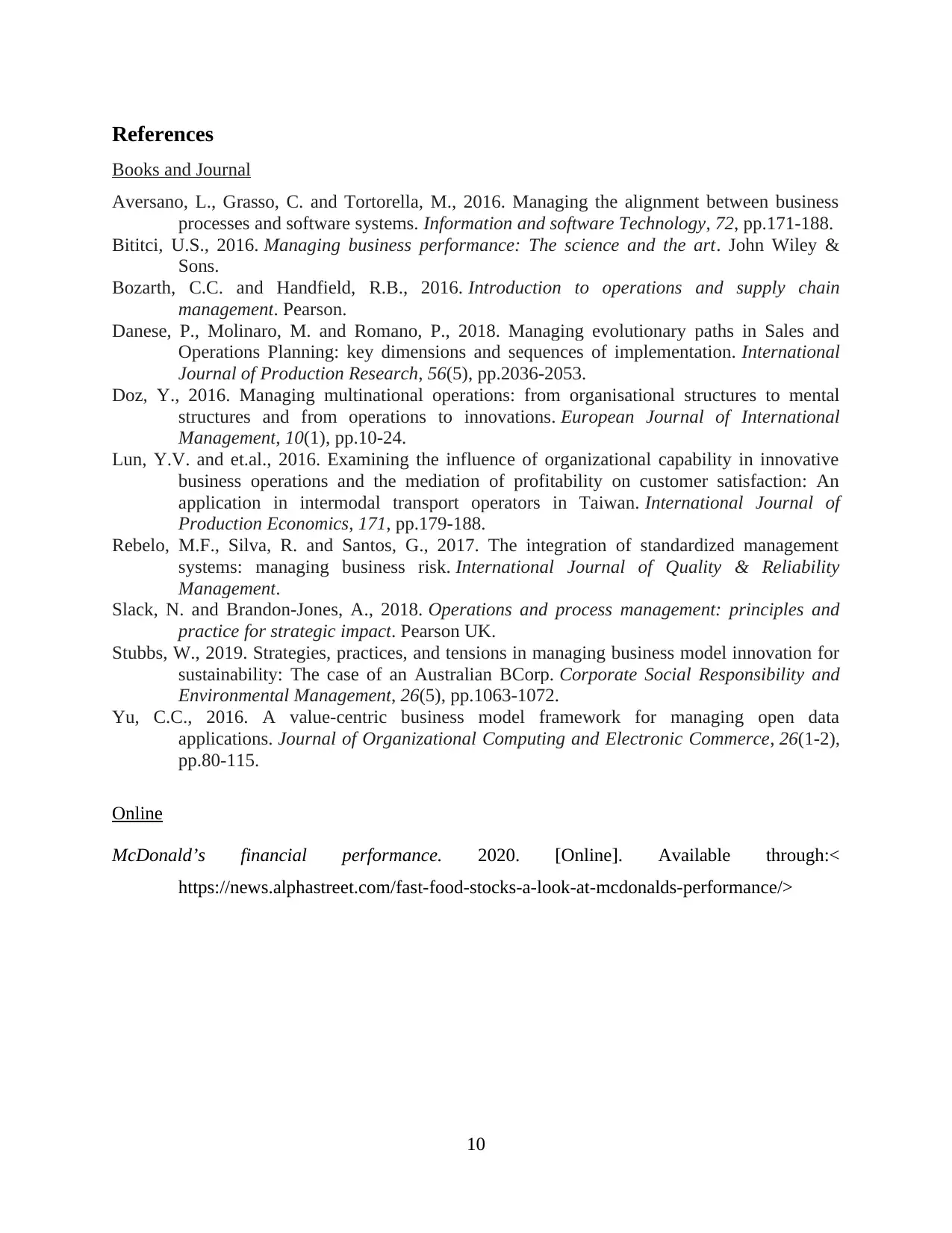
References
Books and Journal
Aversano, L., Grasso, C. and Tortorella, M., 2016. Managing the alignment between business
processes and software systems. Information and software Technology, 72, pp.171-188.
Bititci, U.S., 2016. Managing business performance: The science and the art. John Wiley &
Sons.
Bozarth, C.C. and Handfield, R.B., 2016. Introduction to operations and supply chain
management. Pearson.
Danese, P., Molinaro, M. and Romano, P., 2018. Managing evolutionary paths in Sales and
Operations Planning: key dimensions and sequences of implementation. International
Journal of Production Research, 56(5), pp.2036-2053.
Doz, Y., 2016. Managing multinational operations: from organisational structures to mental
structures and from operations to innovations. European Journal of International
Management, 10(1), pp.10-24.
Lun, Y.V. and et.al., 2016. Examining the influence of organizational capability in innovative
business operations and the mediation of profitability on customer satisfaction: An
application in intermodal transport operators in Taiwan. International Journal of
Production Economics, 171, pp.179-188.
Rebelo, M.F., Silva, R. and Santos, G., 2017. The integration of standardized management
systems: managing business risk. International Journal of Quality & Reliability
Management.
Slack, N. and Brandon-Jones, A., 2018. Operations and process management: principles and
practice for strategic impact. Pearson UK.
Stubbs, W., 2019. Strategies, practices, and tensions in managing business model innovation for
sustainability: The case of an Australian BCorp. Corporate Social Responsibility and
Environmental Management, 26(5), pp.1063-1072.
Yu, C.C., 2016. A value-centric business model framework for managing open data
applications. Journal of Organizational Computing and Electronic Commerce, 26(1-2),
pp.80-115.
Online
McDonald’s financial performance. 2020. [Online]. Available through:<
https://news.alphastreet.com/fast-food-stocks-a-look-at-mcdonalds-performance/>
10
Books and Journal
Aversano, L., Grasso, C. and Tortorella, M., 2016. Managing the alignment between business
processes and software systems. Information and software Technology, 72, pp.171-188.
Bititci, U.S., 2016. Managing business performance: The science and the art. John Wiley &
Sons.
Bozarth, C.C. and Handfield, R.B., 2016. Introduction to operations and supply chain
management. Pearson.
Danese, P., Molinaro, M. and Romano, P., 2018. Managing evolutionary paths in Sales and
Operations Planning: key dimensions and sequences of implementation. International
Journal of Production Research, 56(5), pp.2036-2053.
Doz, Y., 2016. Managing multinational operations: from organisational structures to mental
structures and from operations to innovations. European Journal of International
Management, 10(1), pp.10-24.
Lun, Y.V. and et.al., 2016. Examining the influence of organizational capability in innovative
business operations and the mediation of profitability on customer satisfaction: An
application in intermodal transport operators in Taiwan. International Journal of
Production Economics, 171, pp.179-188.
Rebelo, M.F., Silva, R. and Santos, G., 2017. The integration of standardized management
systems: managing business risk. International Journal of Quality & Reliability
Management.
Slack, N. and Brandon-Jones, A., 2018. Operations and process management: principles and
practice for strategic impact. Pearson UK.
Stubbs, W., 2019. Strategies, practices, and tensions in managing business model innovation for
sustainability: The case of an Australian BCorp. Corporate Social Responsibility and
Environmental Management, 26(5), pp.1063-1072.
Yu, C.C., 2016. A value-centric business model framework for managing open data
applications. Journal of Organizational Computing and Electronic Commerce, 26(1-2),
pp.80-115.
Online
McDonald’s financial performance. 2020. [Online]. Available through:<
https://news.alphastreet.com/fast-food-stocks-a-look-at-mcdonalds-performance/>
10
1 out of 10
Related Documents
Your All-in-One AI-Powered Toolkit for Academic Success.
+13062052269
info@desklib.com
Available 24*7 on WhatsApp / Email
![[object Object]](/_next/static/media/star-bottom.7253800d.svg)
Unlock your academic potential
© 2024 | Zucol Services PVT LTD | All rights reserved.





